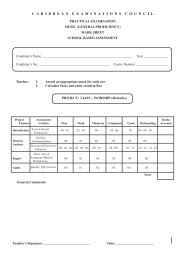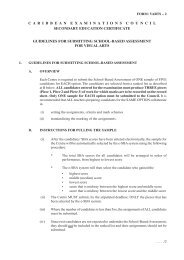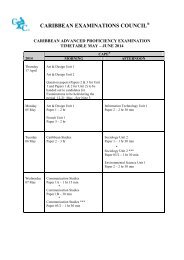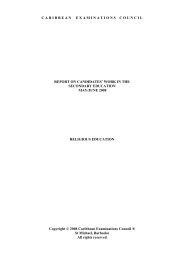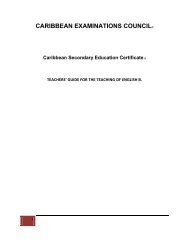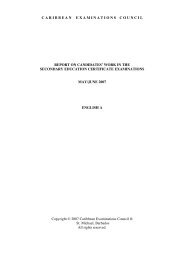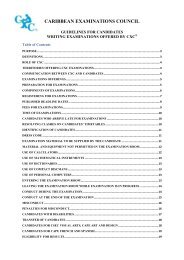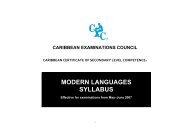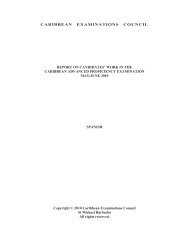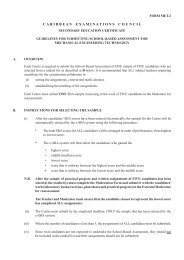Biology - Caribbean Examinations Council
Biology - Caribbean Examinations Council
Biology - Caribbean Examinations Council
You also want an ePaper? Increase the reach of your titles
YUMPU automatically turns print PDFs into web optimized ePapers that Google loves.
-5-Since candidates were able to attain marks across the allotted range for all questions, it is evident thatall marks on the paper were available. However, for more candidates to give their best performanceattention must be paid to observations and suggestions the <strong>Biology</strong> examiners have repeatedly made.Observations and suggestions relate primarily to examination techniques which candidates shouldfollow when writing this paper. In particular, candidate attention is drawn to the use of the stimulusmaterial in responding to the questions and the guidance provided by the spaces allotted to eachquestion where necessary. Candidates must note that they are not required to repeat the questions tobegin their responses for the first three questions on the paper. Candidates also continue to displayweak practical skills especially in planning and designing, manipulating and describing methods ofexperiments and in drawing conclusions from data. These observations suggest that teaching fordeveloping practical skills must include discussions, explanations and rationalizing of procedures andoutcomes on the part of students so that they become capable of developing and manipulatingexperiments and experimental data on their own. Simply having students write up experimentswithout orally communicating what they are doing and providing appropriate explanations foroccurrences squanders the opportunity practicals provide for teaching and learning.Question 1This question dealt with an investigation of the water retention properties of two soil types,classification of soil organisms, some of their adaptations for feeding and also ways of investigatingsoil populations. Candidates were also required to demonstrate planning and designing skills,knowledge of data collection methods and ways of representing data as well as their ability tointerpret data.Candidate performance on this question was quite good. Most sections of the question was well doneby the candidates. The mean was approximately 14 out of 25 and the mode 16 with just over themajority of candidates scoring more than half the marks allotted to the question.Part (a) of the question required candidates to compare pie charts from an investigation of two soilsamples. Candidates were required in Part (a) (i) to calculate the percentage of air in one of thesamples, and in Part (a) (ii) to account for the difference in the proportion of air in the samples. Theseparts of the question were fairly well done by the candidates. The majority were able to calculate thepercentage of air and provide a rationale for the differences based on the additional information thatthey derived. A good answer to Part (a) (ii) was:There is more air in Sample B since there is less clay (more air spaces), and there is less airin Sample A since there is more clay (less air spaces).In Part (b) candidates were required to explore water retention properties in the two soil samples byreading the volumes in the measuring cylinders in responding to Part (b) (i) and identifying thecylinder that showed drainage of a selected soil sample in Part (b) (ii). These parts of the questionwere fairly well done although many candidates omitted the units in recording the volumes in Part(b) (i). Part (b) (iii), which asked candidates to estimate the volume of water retained by each soilsample, was also fairly well done. Part (iv), which asked candidates to identify a source of error in theinvestigation of the soil samples was well done by the better performing candidates. Candidates wereexpected to select responses form a range that included: measuring of the volume of water/soil;drainage time; reading measuring cylinder and so on. A noteworthy candidate response was:
-6-One sample of soil may already have water so that the calculation of the water retainedmay be made in error.Part (b) (v) asked candidates to explain the importance of investigating water retention properties ofsoil. This part of the question was reasonably well done. Candidates were expected to make referenceto: the provision of plants with water held in the soil; different soils hold different amounts of water;can match soil type with plants that require different amounts of water. A good response to thisquestion read:So that one will know which soils are suitable for the growing of plants depending ontheir needs. One will know about the soil and so be able to take suitable measures tobetter equip them for a variety of needs, for example, low water retention causesleaching so one can add humus.Candidates performed reasonably well on Part (c) of the question that assessed candidates‟ knowledgeabout investigating soil organisms. In Part (c) (i), candidates were asked to identify a couple offeatures that they observed on the diagrams of soil organisms presented in Figure 3. In Part (c) (ii),they were to identify a group of soil organisms that is important in recycling soil nutrients. Far toomany candidates identified earthworms as organisms that recycle nutrients. Thus, the expectedresponse was bacteria or fungi. Candidates were generally able to earn the marks allocated to Part (c)(iii), which asked for reasons why certain of the organisms were to be found under stones or leaflitter. Candidates generally recognised that this would allow for: protection from predators;prevention of desiccation; not adapted for dry conditions, need moist habitat. Part (c) (iv) was one ofthe most badly done sections of the question and shows quite clearly the lack of attention paid topractical skill in <strong>Biology</strong>. The majority of candidates had little clue about how to carry out aninvestigation of soil organisms, incorrectly making reference to the use of quadrats along with theabsence of evidence of data collection and recording methods. Candidates were expected to suggestthe use of bottles/traps to catch organisms and to refer to choice of location and timing; placement ofbottles/traps; use of Tullgren funnel, identifying and counting organisms and recording relevant data.Two good responses were:In the habitat dig holes and place bottles covered with leaves to produce pitfall trapsto trap Organism 5.Distribute the bottles in the entire areaCollect the bottles after one dayCount the number of the populationAndSelect and name a suitable habitatDig holes at regular intervals and bury bottles leaving the mouths at the surface ofthe groundLightly cover with grass and leave overnightTake bottles to the lab, observe the results by counting the organisms
-7-Tabulate observationsPart (c) (v) asked candidate to define the term „carnivore‟ and give two adaptations a carnivore in thesoil sample should have. This question was fairly well done, even though quite a few candidates heldsome misconceptions about carnivores. Some candidates believe that carnivores feed on herbivoresonly or that they are living things with backbones. With respect to the adaptations, most candidateswere able to access one of the two available marks. Candidates were expected in their responses torefer to: locomotory structures, fast movement; mouth parts for trapping, biting, piercing; cutting,developed sensory system for detecting prey. Examples of good responses were:Two adaptations are sharp teeth or stingers and poison or venom to stun and kill prey… mouth parts to trap and kill animals and should be able to move quickly or to be wellcamouflaged to catch them. Therefore, have a great number of legs or be colored tomatch the colour of the habitat.MisconceptionsQuadrats or nets can be used to determine the population of organisms in a leaf litter.Carnivores eat „organisms‟. They should note that the term „organism‟ refers to bothplants and animals.Carnivores are living things without backbones.All invertebrates are insects.Earthworms recycle soil nutrients.Recycling of nutrients only involved organisms which physically break down thematerial, for example, earthworms.Question 2This question tested candidates‟ knowledge of parts of the appendicular (joint) and axial (vertebrae)skeleton in humans. Candidate performance on this question was disappointingly weak although notentirely unexpected. The mean was five and the mode was three.In Part (a), candidates were to label the parts identified by numbers on diagram of the mammalianjoint illustrated in Figure 4 (Part (a) (i)) and state the function of two parts selected from the diagram(Part (a) (ii)). Part (a) (i) was very poorly done. Candidates were expected to label as follows: 1 –synovial membrane; 2 – synovial fluid; 3 – cartilage; 4 - bone. Since these are commonly knownparts of a joint, it is quite surprising that many candidates failed to provide accurate labels, and toooften interchanged the names or incorrectly spelt the names. Performance on Part (a) (ii) wassomewhat better in that many candidates were able to relate the synovial fluid to lubrication of thejoint to reduce friction and the bone with providing attachment for muscle, its role in movement,support or red blood cell production.
-8-Part (b) also proved challenging for a large number of candidates. They were required in Part (b) (i)to name a partially movable joint. Few candidates knew that the wrist, ankle (gliding/sliding), atlasand axis (pivot) are classed as partially movable. Part (b) (ii) was fairly well done since a fairly largenumber of candidates recognised the elbow as a hinge joint which allows gross movement – flexingand extending the lower arm, over a wide area. Many, however, were vague in referring to thelimited or restricted movement in the partially movable joint in making the comparison betweenmovement at the two types of joints which Part (b) (ii) of the question asked.Part (c) required candidates to complete a diagram of a human forelimb to illustrate how antagonisticmuscles are aligned. This part of the question was fairly well done in that while candidates knew thatantagonistic muscles, in this case, the biceps and triceps are on opposite sides of the humerus, manyhad little knowledge of how they were attached to the radius/ulna.In Part (d), candidates were asked to explain how in older persons the hip bone can lose itslocomotory function. This part of the question was also fairly well done. Candidates were expected toinclude in their responses ideas such as: the hip bone carries the weight of the torso; loss of bonemass/erosion of cartilage at joint possible; reduction of synovial fluid; increased friction at joint;physical damage to the hip bone through injury possible. Thus, in general candidates recognised thatlocomotion could be impaired through a loss of effectiveness at the joint. A good response to this partof the question was:Cartilage around the ball and socket joint may wear away causing frequent rubbing ofbones. Older persons may lack calcium in their diet giving rise to brittle bones especiallythose of the hips. Both cause pain during walking or movement of the hip joint.Some misspelt words included:Cartilage – “cartalage”, “cartillage”Synovial – “sinoval”, “cernovial”Wrist – “rist”, “wrisk”MisconceptionCranium is a partially movable jointHinge joints move in two planes, back and forthQuestion 3This question required knowledge of the process of meiosis and its implications, as well as theprocesses involved in genetic engineering. The question was reasonably well done given that thetopic is among the more challenging aspects of the CSEC <strong>Biology</strong> syllabus. The mean was 4.5 out of15 with a mode of three. Very well prepared candidates were able to attain marks across the full rangeavailable for the question.Part (a) of the question dealt with aspects of meiosis based on the representation on a diagramshowing chromosomes in a dividing cell that was labelled Figure 6. Candidates generally providedaccurate labels of the chromatids and centromere respectively which were required in Part (a) (i) andwere able to identify the process as meiosis which was asked in Part (a) (ii). While several candidateswere able explain why the process was indeed meiosis required in Part (a) (iii), many more were
-9-unable to articulate their reasoning. Candidates were expected to refer to: pairs of homologouschromosomes separating; centromere intact; evidence of crossing over in homologues. An excellentresponse was:…pieces of chromosomes have been exchanged. This only occurs in meiosis. Thechromosomes are being separated and are still composed of 2 chromatids joined at thecentromere….Part (a) (iv) asked candidates to indicate the number of chromosomes in the daughter cells producedin the cell division illustrated. A majority of candidates obtained the mark allocated to the question,but far too many ignored the stimulus material and gave the number of chromosome in a humangamete, which was not asked for. For Part (a) (v), candidates were to give two advantages of meioticcell division. Candidates were expected to refer to concepts such as: maintenance of the geneticnumber through successive generations; gametes different/offspring show variation; increase chancesof survival as environmental conditions change. A good response was:It can produce genetically different offspring which may be of better quality. Theorganisms‟ offspring which are genetically different may be able to surviveenvironmental conditions if they change drastically.Part (b) of the question assessed candidate knowledge of genetic engineering and its implications. InPart (b) (i), candidates were to define the term „genetic engineering‟. Candidates for the most part didnot draw on the significance of manipulating genes and that the process was done at the sub cellularlevel. They were expected to indicate that: genetic engineering involved the transfer; humanmanipulation; across species; at the sub-cellular level; not limited to or by species. A gooddefinition was:Genetic engineering is the insertion of genes into the DNA of one organism from anotherby humans.In Part (b) (ii), candidates were to give an advantage of genetic engineering. This part of the questionwas well done. Candidates were expected to refer to: faster change in trait; targeted traits involved;any trait can be manipulated/changed; any organism can be affected/changed. In the followingexample this candidate illustrated how genetic engineering might be used to help find a cure forsystemic, difficult-to-cure diseases:Diseases such as cystic fibrosis may be cured by inserting new healthy genes in place ofgenes carrying the disease.However, challenging for candidates was Part (b) (iii) in which they were to identify possibleproblems that could arise with genetically modified organisms. Candidates were expected to refer tothe unknowns about modified traits and their impact on the environment: the new trait may causeorganism to impact the environment differently and negatively; change in role in food chain, web;ability/inability to switch genes on and off.Part (c) of the question asked candidates to explain why gene transfer between species is successfuleven though those species cannot normally interbreed. This part of the question was not well done bycandidates. Candidates were expected to indicate that in general, organisms similar at the geneticlevel; gene structure is the same in all living things; transfer of genes possible between vastly
-10-different species; interbreeding is a complex of activities – involving many structures and processes,gametes different. A response that gained full marks was:This is possible because humans are controlling the gene transfer by inserting the genesdirectly into the DNA of an organism … normally, species do not interbreed as theycannot easily fertilise eggs of another speciesMisconceptions/misconstructions:Lack of understanding that genetic engineering occurs at the sub-cellular levelLack of understanding that genes of all living organisms have a universal structureQuestion 4This question assessed the depth of candidates‟ understanding of the energy flow in ecosystems andtheir ability to evaluate the principles and implications of biological control. Approximately half ofthe candidates obtained over half the available marks for this question. The performance was thusquite good. The mean was almost seven out of 15 and the mode was eight.Part (a) (i) of the question dealt with energy flow to and within ecosystems. The concept of plants asproducers for the system because of their unique light- absorbing and energy conversion characteristicwas widely understood. A good response was:They are the only organisms that can readily make use of the sun‟s energy. They use itto perform photosynthesis by which they make their food; herbivores eat these plants togain energy and carnivores eat the herbivores and other carnivores for energy.In Part (a) (ii), candidates were required to show how a plant or animal may belong to more than onefood chain. While many candidates were able to draw reasonable diagrams with multiple food webs,they should note that normally labels, annotations and peripheral writings should be used to explainconcepts and ideas presented in illustrations. In Part (a) (iii), candidates were required to explain whythe number of organisms decreases at successive trophic levels. This part of the question was poorlydone by several candidates, because they were unable to relate the decrease in number of organisms toenergy loss to the environment. Further, simply stating that energy is lost is an inadequate response.Candidates were expected to include in their responses the ways in which energy decreases up thefood chain, as it is used up by organisms for metabolic processes, through heat loss in physiologicalprocesses, for example, respiration, excretion or in ejestion. The following are examples of goodresponses. The first is succinct and to the point, while the latter illustrates how a good explanation isdeveloped:The number of organisms decreases at successive trophic levels because as we go uptrophic levels, the energy passed on becomes less and less. In fact 90% of the energy isused, lost by heat etcetera because of the low energy being passed on, the trophic levelscan only support fewer organisms…… because at each level the amount of energy decreases. Energy is highest at the firsttrophic level because the sun‟s energy is abundant and only plants can make use of it forfood. As herbivores consume plants they use some of the energy and store the rest, but
-11-to get enough energy one herbivore may eat a lot of plants, therefore the number ofherbivores is less than the number of plants …Part (b) of the question assessed candidates‟ knowledge of biological control and its implications.This part of the question was quite well done by able candidates, but presented a challenge to lessable ones. For example, those candidates who were unable to identify a relationship that is importantin biological control, which was one of the requirements of Part (b) (i) of the question, found greatdifficulty in explaining how the relationship functions in biological control, which was the otherrequirement of this part of the question. Candidates were expected to identify a predator /preyrelationship or parasite/host relationship in their responses. In Part (b) (ii), candidates were to suggestreasons for a preference of biological control over the use of pesticides. Candidate response variedfrom coherent, well articulated arguments to the citation of totally irrelevant reasons such as “globalwarming” and “eutrophication”. Candidates were expected to refer to biological control as not likelyto pollute the environment, contaminate food and drinking water and that pesticides had the potentialto harm organisms not targeted. Many candidates made reference to the development of resistance topesticides, which, while valid, was too often poorly explained. Or they used terms vaguely, forexample, “environmentally friendly” with insufficient explanation. Good responses to Part (b) (ii)were:Firstly the use of pesticides poses the risk of bio-accumulation. This happens as a resultof the chemicals accumulating in the bodies of organisms as we go up trophic levels. Itusually affects the organism at the last trophic level most.… chemicals could begin to accumulate in the soil and plants, poisoning and killingother organisms that feed on them and those connected in food chains. Extreme casescould cause mass destruction or even species extinction. The water in the soil could getaffected … overuse of pesticide may also cause the pest to become resistant to it …Misconception:Candidates often misinterpreted the use of pesticides in biological control makingincorrect inferences to crops and plants.Pests become “used” to pesticides by antibody production.Organisms develop “immunity” to pesticides.Question 5This question required knowledge of the structure and function of the respiratory system in humans,factors that affect respiratory surfaces and the negative impact of human activity (factory emissions,cigarette smoke) on the environment. Candidate performance on this question was also good with amean of 6.5 out of 15 and a mode of four.Part (a) of the question tested candidates‟ knowledge of the structure of the human lung and how it isadapted for oxygen absorption. In Part (a) (i), they were to explain with the aid of a diagram how airreaches the lungs and oxygen absorbed into the blood stream. While the majority of candidates wereable to provide an adequate explanation, the accompanying diagrams were indeed poor. This reflects alack of appropriate drawing skill and is consistent with poor illustrations in SBA books. More
-12-attention must be paid to developing candidates‟ drawing skill. Candidates were expected to includein their responses reference to air passing through the nasal passage, bronchi/bronchioles,lung/alveoli and then to the capillaries surrounding the alveoli; the functioning of the ribcage anddiaphragm in inspiration; oxygen dissolving in the moisture of the alveoli lining and diffusion ofoxygen into the capillaries. Several candidates were confused about where oxygenation of the bloodtook place and how the oxygen in the alveoli actually got into the blood stream. Part (a) (ii) askedcandidates to suggest why it is important for human blood to have a specialized cell for oxygenabsorption. This part of the question was not very well done. They sometimes referred to “surfacearea to volume ratio” but were generally vague in their explanations. They also tended to focus onwhat were the specializations of the red blood cells rather than the reasons for the specialcharacteristics. Candidates were expected to include in their responses ideas such as: oxygen isrequired by all cells; blood is the only means of supplying oxygen to all cells; many more cellsrequiring oxygen than cells of respiratory (absorptive) surface; specialized cells adapted to take uplarge quantities of oxygen and give up same to the cells that require oxygen.Part (b) required candidates to suggest why comparing the effects of smoke emissions from factorieson leaves with the effect of smoking cigarettes on human lungs is appropriate. This question waschallenging for many candidates. While they recognised that the leaves and lungs were indeedrespiratory surfaces they could not rationalise the comparison. Candidates were expected to refer tothe following facts: smoke contains tar/solid particles; particles block stomata/ clog alveoli;reduction of gaseous exchange surface area, reduction of availability of gases in both humans andplants.Part (c) asked candidates to explain why governments should consider it their responsibility to reducesmoking in public. This part of the question was well done with most candidates gaining the marksallotted. A good response was:They (the government) should consider it their responsibility because smoking causeslung cancer, chronic bronchitis and other diseases. The number of persons with thesediseases can be increased if the public is exposed to second-hand smoke and thus cancause a strain on the country‟s health services. Also, most smokers are young men andwomen and when they become sick there are fewer working people in the population toprovide income for the country.MisconceptionsNo difference between the trachea and oesophagus.Oxygenation of blood took place in the heart.Carbon monoxide is interchangeable with carbon dioxide.How acid rain is formed.Low availability when carbon monoxide is present.Question 6This question investigated candidates‟ knowledge of diseases and how the body is able to defenditself against diseases, antibiotics and implications of improper use as well as the impact of alcohol
-13-abuse. Performance on this question was good with a mean of seven out of 15 and a mode of seven,giving a classically normal distribution curve. Candidates were able to access marks across the fullrange allotted to the question.In Part (a) candidates were asked about the body‟s disease defence system and its effectiveness. InPart (a) (i), candidates were asked to explain how the body defends itself against disease. Candidatesoften did not provide a comprehensive enough account of the functioning of the immune system.Candidates were expected to include among other concepts: clot formation; role of white blood cells,immune system response including production of antibodies, destruction and removal of antigens,memory cells and their role. For Part (a) (ii), of the question candidates were required to identifydiseases against which the body could not effectively defend itself. Most candidates were able to giveat least one relevant disease which was often a viral disease such as HIV and AIDS. Too manycandidates named obscure diseases when the obvious hereditary, for example, sickle-cell anaemia,physiological, for example, diabetes or hypertension and viral diseases were the expected responses.In Part (a) (iii), candidates were expected to indicate why it is difficult for the body to defend itselffrom one of the diseases identified in the previous section. Candidates were expected to indicate thatthese diseases were generally not caused by pathogens or antigens that trigger the immune system orthat they attacked and or destroyed the immune system itself or that the disease manifested at a subcellular level that the immune system could not easily detect. A good response from a candidate whoindicated that the body has difficulty defending itself against a hereditary disease was:It is difficult for the body to defend itself against hereditary diseases because thesediseases are transferred in the genes of the parent to the offspring. They are not causedby pathogens and so cannot be acted upon by antibodies or phagocytes and must betreated differently for example, gene therapyPart (b) asked candidates for two biological and two social implications of the improper use ofantibiotics. This part of the question was not generally well done as candidates had to recognisethat antibiotics are drugs that are used to treat diseases caused by bacteria and their actions arerather specific to bacteria. Thus, candidates were expected to refer to: antibiotics used to treatbacterial diseases; development of resistance of bacteria to antibiotics when dosage not adheredto; increased chances of new strains of bacteria developing when antibiotics improperly used;lack of effectiveness of treatment. With respect to the social implications of the improper use ofantibiotics, candidates performed reasonably well and many alluded to the financial burden on thecommunity/country. They were expected to include in their answers: cost of health care/treatmentof diseases; increased incidence of disease; susceptibility to epidemics; burden on families. Agood response to this part of the question with respect to biological and social implications of theimproper use of antibiotics was as follows:Two biological implications of the improper use of antibiotics are:1. The bacteria will become resistant to antibiotics and will remain unharmed in thebody.2. The surviving bacteria will be stronger than its predecessor and will need an evenstronger antibiotic prescription to be killed.Two social implications of the improper use of antibiotics are:1. The cost of extra doses of antibiotics and relevant research.
-14-2. If the disease is communicable, the resistant strain of bacteria may infect otherpersons increasing cost for research and medication.Part (c) of the question required candidates to offer an explanation for sometimes describing alcoholas an abused drug. This question was fairly well done by candidates. Many focused their responses onthe effect on the nervous system including the feeling of euphoria and change of behaviour includingaddiction in those who consume excessive amounts. Candidates were indeed expected to develop theirresponses around the ideas of: alcohol is a depressant of the nervous system; alters normalfunctioning of the body; addictive for some people/increase dependence; drinker becoming moresociable and self-confident/feeling of euphoria/less social responsibility; need to drink excessiveamount to maintain euphoria; need to be treated as any other disease that must be controlled.MisconceptionsAntibiotics are used to treat any or every type of disease.Antibiotics can be used to treat viral disease.One can overdose on antibiotics in the same way one can overdose on alcohol or illegaldrugs.PAPER 03 – School-Based AssessmentGENERAL COMMENTSPerformance on the School-Based Assessment was reasonable. The syllabus coverage for centres wasgenerally good and it was evident that there was some attempt to conduct practical activities for mostskills. However, while the skill of Observation, Recording and Reporting (ORR) was generally welldone, Analysis and Interpretation (AI) and Planning and Designing (PD) continue to presentcandidates with the most difficulty. It is recommended that more practical work, and work providingopportunity for developing these specific skills, form a greater part of the <strong>Biology</strong> course. In general,practical work should have an experimental approach that facilitates the development of criticalexperimental skills which is a major goal of the SBA. Efforts must also be made to include fieldworkfor each batch of candidates.A review of previous school reports will provide further suggestions for developing practical skills.Further suggestions are reiterated in this report and each teacher is alerted to the specific strengthsand weaknesses displayed by their candidates in the Moderation Feedback Form sent to schools fromCXC, after moderation. Teachers should also review the 2002 School‟s report to obtain an overviewof the moderation processes and the expectations of the moderators.While the quality of the books submitted from several centres was good, there are still some centresthat submitted books without the requisite information. The CXC <strong>Biology</strong> syllabus providesguidelines for the preparation of practical books for submission. Some of the requirements include: aTable of Contents with aims of the practical activities, page numbers, dates, and a clear indication ofthe skills being assessed. In addition, the marks awarded for each practical activity must be placed
-15-aside the practical and not listed at the front or back of the books. There must also be clear andspecific indication of the activities that are used for the SBA.The moderation exercise is too often hampered by poor mark schemes. These must be prepared andsubmitted with due care and attention. Mark schemes must be legible and preferably bound togetherinstead of on loose sheets of paper. There must be a clear and direct relationship between the marksawarded to the appropriate activities in the practical books and to the marks on the tally sheets. Itshould also be noted that no more than two skills should be assessed in a practical activity.The following is a list of criteria which teachers should follow in marking SBA activities.Marks should be awarded for each skill separately. It is noted that in some cases, markswere given for each skill, then tallied to give a composite score.Marks awarded to students‟ work should be a fair indication of its quality. Too manystudents received high marks for work that obviously fall short of the CXC standard. Thiswas particularly noticeable for Planning and Designing, Analysis and Interpretation, andDrawing. When the CXC standard is not observed there is great disparity between theteacher‟s score and that of the moderator. This circumstance is usually disadvantageousto the students.Marks submitted on the moderation sheet should reflect the candidates‟ marks in each ofthe samples. Consistency of marking and submission of marks relate to the reliability ofthe process and thus acceptability of marks submitted.Teachers are once again reminded that body fluids such as saliva, blood and urine are notto be used for practical work. These can be sources of infection and may have seriouslegal implications should a student become infected while conducting practical work.Plant materials must be removed from books before they are submitted to CXC, sincethese are also potential agents of infection when moved from place to place.Fieldwork, both quantitative and qualitative aspects, is critical to the study of <strong>Biology</strong> andmust be included in the SBA submissionsThe moderation feedback form, which is sent to each centre, provides constructive and usefulinformation relevant to the particular teacher(s). This form offers specific recommendations and isintended to assist teachers in the planning, conducting and assessing practical work – in the laboratoryand field. Improvement of students‟ practical skills will have a direct influence on candidate overallperformance in the <strong>Biology</strong> examination, since certain questions, notably Question 1 on Paper 02, arebased on knowledge and application of these practical skills.SPECIFIC COMMENTS ON THE ASSESSMENT OF SKILLSObservation, Recording, Reporting (ORR)These skills appear to have been mastered at most centres. For most of the work observed, themethod was clearly described with logical sequence of activities. The tables and graphs were clearand provided adequate details which allowed for clear description and discussion of the experiment. It
-16-was also observed that except for a few centre, the past tense was correctly used in the presentation ofthe report on the practical activity.The importance of fieldwork is reiterated here. At some centres, little or none is being done. Manycentres that attempted fieldwork frequently neglected quantitative or qualitative investigations. Bothaspects of fieldwork are expected. Investigations need not be elaborate but students should be giventhe opportunity to explore the environment and make observations about the relationships amongliving organisms and their environment.Drawing (Dr)The number of drawings included in candidates‟ practical books, as well as the quality of thedrawings, continue to be of concern to the <strong>Biology</strong> Examining team. At too many centres poordrawings were awarded high marks. Drawings are not expected to be works of art, but they shoulddemonstrate an adherence to the guidelines for accuracy, clarity, labeling and magnification. Studentshave to be given several opportunities to develop drawing skills. The larger the number of drawingsstudents have to produce, the more opportunity they have to practise, and develop the skill. It is alsoemphasized that drawings must be practised from actual specimens and not from textbooks. Thiscomment has been stressed in several school reports.Teachers must ensure that their students draw samples of flowers, fruits, storage organs and bones.Additional examples may be included in practical books. However, microscope drawings shouldnot be used for SBA. It is very useful for students to see and attempt to record what they do seeunder the microscope but at this level these drawings should not be used for SBA. Similarly,dissections may help students to understand structures such as the digestive system but they are toocomplex to be drawn accurately at this level. These difficult drawings do not provide a fair test ofability at this level.Analysis and Interpretation (AI)This skill continues to present problems for the majority of candidates. The processes involved indemonstrating this skill are reiterated here.Discussions are expected to provide some background information or the general principles on whichan investigation is based. Results should then be explained. When a control is used it provides a pointof comparison for the experimental set up in which a particular variable has been omitted. Thiscomparison should be included in the discussion as it is the key to drawing the conclusion.Conclusions should relate directly to the aim of the investigation. Students should also be reminded todiscuss at least one limitation of the investigation. It is important for them to recognise that theconditions present in a school laboratory are rarely ideal.Many teachers continue to use questions to stimulate discussion. This device is good for helpingstudents to develop their AI skills. However, they should not be used excessively, nor should they bethe only means of assessment. These questions must guide students to provide the requiredbackground information, give explanations for the results, draw conclusions and show an awarenessof possible limitations. The information provided in this way should then be written up as a paragraphof continuous prose as is normally done for the discussion/ conclusion. In many cases, candidatesseem to have learnt a formula for writing up the discussion but showed no real understanding of howto interpret their own results. As a learning strategy teachers may ask their students to orally explain
-17-the results to obtain a clearer view of their understanding and to help them develop their analyticalskills.It should be noted that food tests on their own are not appropriate for assessing AI. Simpleinvestigations can be designed in which food tests are used. For example, students can be givenunknown mixtures and asked to find out which food would be most suitable for an infant. Food testscan be used also to determine the presence of a particular food before and after digestion by anenzyme. These types of exercises will allow students to develop the necessary skills. Knowledge ofthe food tests and the nutritional requirements can then provide the background information on whichthey will base their conclusions.Moderators were also concerned about the narrow range of investigations assessed for AI. With theexception of patterns of growth in seedlings, very few candidates seemed to have been exposed toinvestigations other than experiments. Investigations that require collecting observations over a periodof time are ideal for discussing limitations as they lack controls and so many variables may change.These limitations can then be used as the basis for planning and design exercises. For example,students can be asked to find out which of the flowers in a garden butterflies prefer or what types ofmoths a house lizard eats by completing a table of observations over a period of days or weeks. Theycan then use the observations to develop a hypothesis and design an investigation that would test it.Manipulation and Measurement (MM)As in previous years, the marks for this skill were good. However, as was stated in previous reports,in many cases there was reason to believe that these marks were not the result of rigorous marking. Ifvirtually all students in a class gain full marks on an activity, perhaps the task is not demandingenough or the criteria not detailed enough to allow the necessary discrimination between differentlevels of performance. It is important that students be exposed to a wide range of apparatus and theiruse in collecting data. This would help to ensure the development of the skill and give a fairerassessment of student competence in MM. Teachers are reminded that marks for MM must be writtendown in the laboratory books next to the laboratory practical for which they were awarded and markschemes and detailed criteria submitted as done for all other skills.Planning and Designing (PD)Performance on this skill was fair. Most experiments designed by the students indicated that there wassome understanding of the procedures involved in planning and conducting an experiment. There arestill a few areas of difficulty where candidates were unable to state their hypotheses clearly and relatethe aim to the hypothesis. In some instances, there were no replicates in the investigations.There is room for more creative experiments. Teachers should take examples from their environmentthat would challenge the ability of their students. It is also important that development of the skillstart with the commencement of the teaching of the syllabus. In many cases it was obvious thatpractical activities targeting the development of the Planning and Designing skill was among the lastset of activities in which the candidates engaged prior to the examinations. Figure 1 is a noteworthysubmission from 2005 SBA which clearly illustrates how a planning and designing activity might beeffectively developed.
-18-Example:This Planning and Designing activity submitted by a centre was based on the observationthat “A boy notices that all the trees around his yard except the grapefruit tree wereinfested with ‘duck’ ants”. The students were required to plan and design an experiment todetermine what was responsible for the difference in infestation. An example of anappropriate hypothesis and a relevant aim for investigating the hypothesis was:Hypothesis: ‘Duck’ ants will appear on some trees but will not be present ongrapefruit trees because the leaves contain a chemical that repels the antsAim: To investigate whether ‘duck’ ants are repelled by a chemical from theleaves of the grapefruit tree.There was a clear description of the materials and method. Students planned to extract thesubstance from the leaves of the grapefruit tree, which may be responsible for the repellanteffect, along with extracts from the leaves of other trees as an appropriate control. The„duck‟ ants would then be placed near drops of each of the extracts in petri dishes. Themeasurable variable would be the number of „duck‟ ants that leave or remain in each dish.Results would then be tabulated and subsequently discussed.As stated by the candidates, one limitation may be that „the chemical in the leaves thatcause the effect on the „duck‟ ants may be affected by the extraction‟. Appropriate markswere awarded for the various aspects of the experiment.Figure 1. Example of a good Planning and Designing activity



